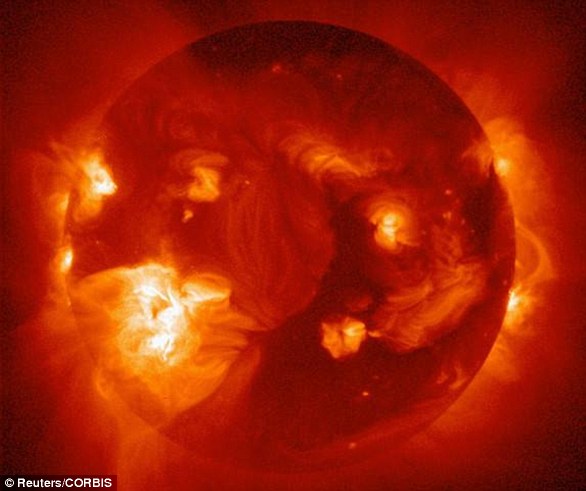Northern Lights in more than 20 US states TONIGHT – here is how YOU can see the colorful aurora borealis
>
Tens of millions of Americans will enjoy views of the Northern Lights tonight, as solar storms push the spectacular display southward.
More than 20 states from the East Coast to the Pacific Northwest will be able to catch their best glimpses of the phenomenon, known as the aurora borealis, between 10 p.m. and 2 a.m. local time.
The lights should begin appearing as far as Iowa and Ohio after nightfall, and could continue until Friday evening, although the aurora borealis will not be visible after that, according to space meteorologists.
Alaska, Montana, North Dakota and Minnesota will have the best seats in the United States.
But skywatchers in Washington, Oregon, Idaho, South Dakota, Wyoming, Nebraska, Wisconsin, Illinois, Indiana, Michigan, Pennsylvania, New York, Vermont, Rhode Island, Massachusetts and Maine will also get a chance to see these lights twinkling.
To the naked eye, the aurora will appear as a green or red glow in the northern sky.
The Northern Lights are most commonly seen in places near the Arctic Circle such as Scandinavia and Alaska, so any sighting over the continental United States is a treat for skygazers.
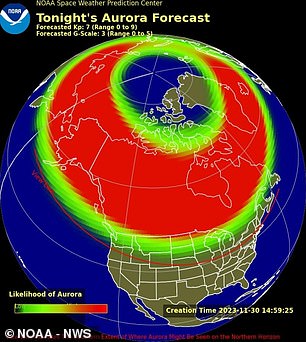
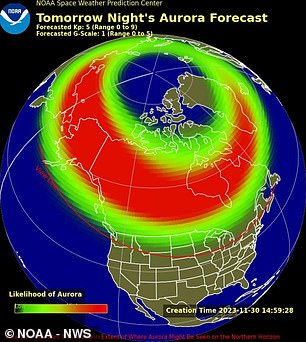
The aurora forecast for tonight, November 30, 2023, will spread deeper into the continental United States than usual, according to NOAA's Space Weather Prediction Center, thanks to a wave of incoming solar storms. Tomorrow night's forecast calls for a decrease in the northern lights in the south
According to the National Oceanic and Atmospheric Administration's (NOAA) Space Weather Prediction Center, at least four “coronal mass ejections” (CME) have exploded from the Sun's surface and are now heading toward Earth.
Coronal ejection events, often a byproduct of solar flares and other turbulent conditions on our Sun, cause a strong magnetic field and a mass of plasma to pass through the Sun's outer “coronal” edge and out into the wider Solar System.
For tonight and tomorrow, NOAA's Space Weather Prediction Center has upgraded its forecast to G3 Watch (“strong” on a scale of 1 to 5), as they observe these coronal emissions beginning to merge into space.
“With 3 incoming CMEs already, the addition of the fourth full corona CME prompted forecasters at SWPC to upgrade their G2 Watch on December 01 to a G3 Watch,” NOAA posted on the website. Their prediction site.
“This faster-moving corona of coronal ejection is (expected) to merge with 2 of 3 CMEs, all of which will reach Earth on December 1,” the federal agency said.
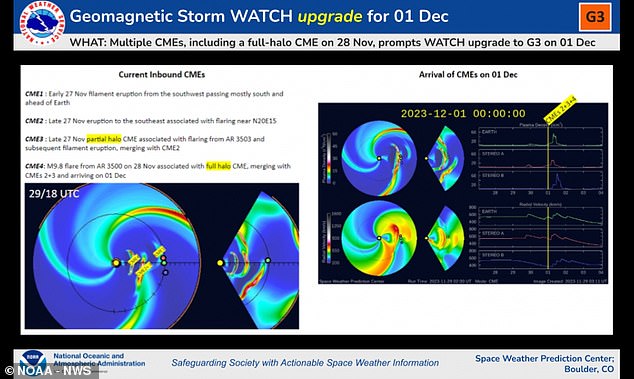
NOAA's Space Weather Prediction Center upgraded its forecast to the G3 watch (“strong” on a scale of 1 to 5), where they observed “solar storms” merging from coronal ejections in space: “This fast-moving CME[will]” merge with… 2 of 3 CMEs, all arriving at Earth on December 1
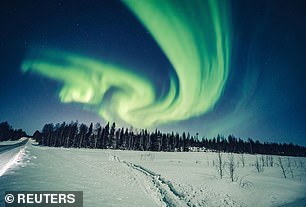
The northern and southern lights (aurora borealis) have mystified humans for centuries because of their wild colors. Above, an aurora glow over Rovaniemi, Finland on February 6, 2020
The aurora forecast for tonight, Nov. 30, 2023, will spread deeper into the continental U.S. than usual, according to NOAA's Space Weather Prediction Center, thanks to the buildup of incoming solar storms.
Tomorrow night's forecast is a little less strong, with less of the northern lights visible in the south as this wave of CME streams farther into our solar system toward Mars and Jupiter.
However, sky watchers in the United States shouldn't give up hope if they missed the rare local aurora on Thursday night, as astronomers and space weather forecasters at the National Oceanic and Atmospheric Administration (NOAA) expect more similar coronal ejection events in the next few months.
Since December 2019, the Sun has been going through an 11-year cycle in which the polarity of its magnetic poles completely reverses, approaching its most turbulent, high-energy phase.
This cycle, called solar cycle 25, which consists of 11 periods, is expected to be a “fairly weak cycle,” according to National Weather Service.
However, they will continually increase in intensity between now and July 2025, with an expected peak of 115 sunspots, stronger coronal ejections, and other solar storms such as high-speed coronal hole streams (CH HSS).
according to The hillThe new forecast indicates that storms “could come faster and be stronger than previously thought from January to October next year.”
While that promises even more beautiful nighttime light shows from these northern lights to the south, CMEs can also affect our infrastructure, such as indirect impacts that can disrupt satellites.
According to Royal Museums Greenwich, most of the particles generated by these solar events are deflected, but some are trapped in the Earth's magnetic field.
They are accelerated towards the north and south poles in the atmosphere, which is why the aurora is usually best seen near the magnetic poles.
“These particles then collide with atoms and molecules in Earth's atmosphere and essentially heat them up,” said Tom Kearse, an astronomer at the Royal Observatory.
“We call this physical process ‘excitation,’ but it is very similar to heating a gas and making it glow.”
This results in beautiful displays of light in the sky, which come in all kinds of different colors.
Oxygen emits green and red light, while nitrogen glows blue and violet.
(Tags for translation)dailymail

